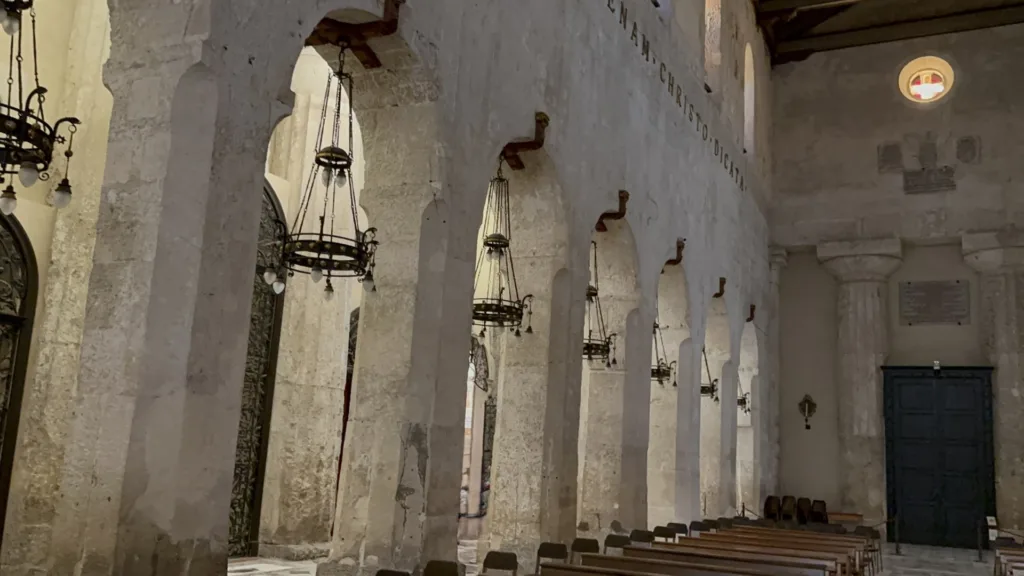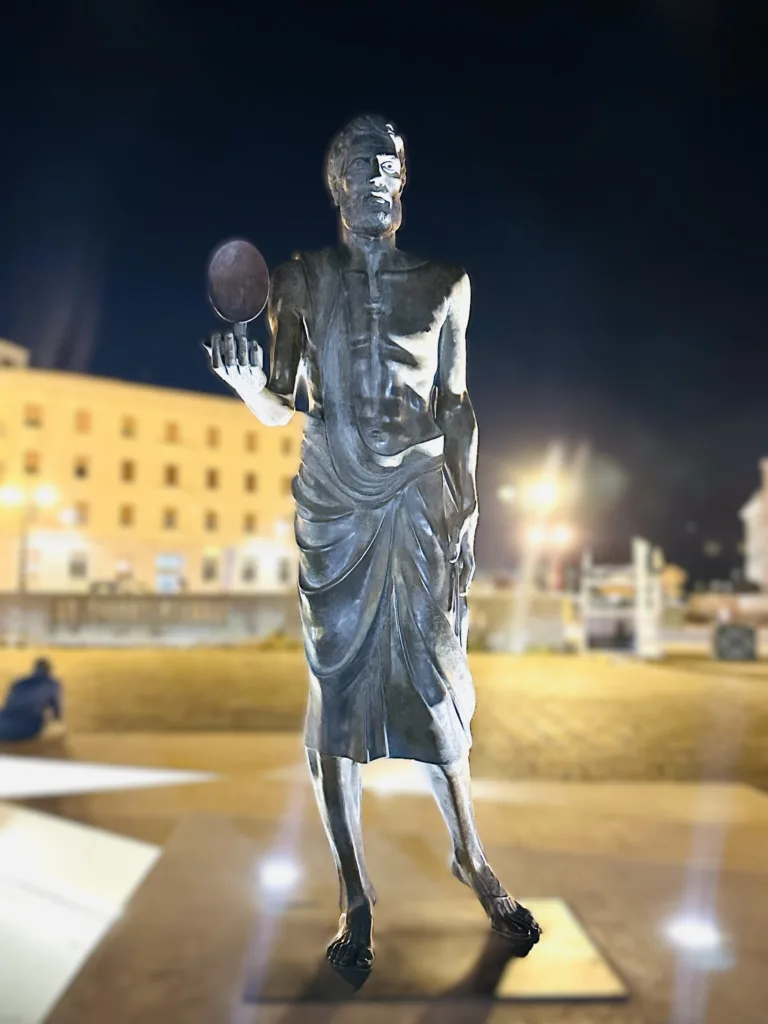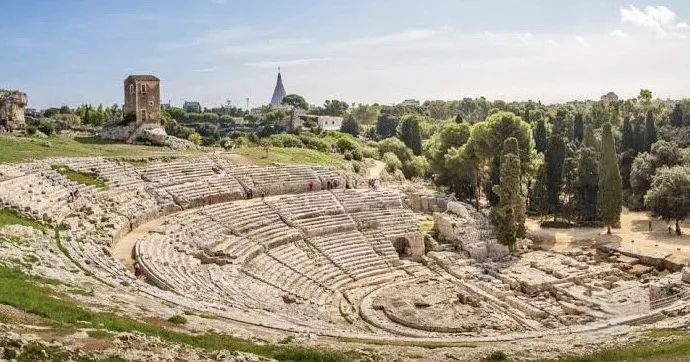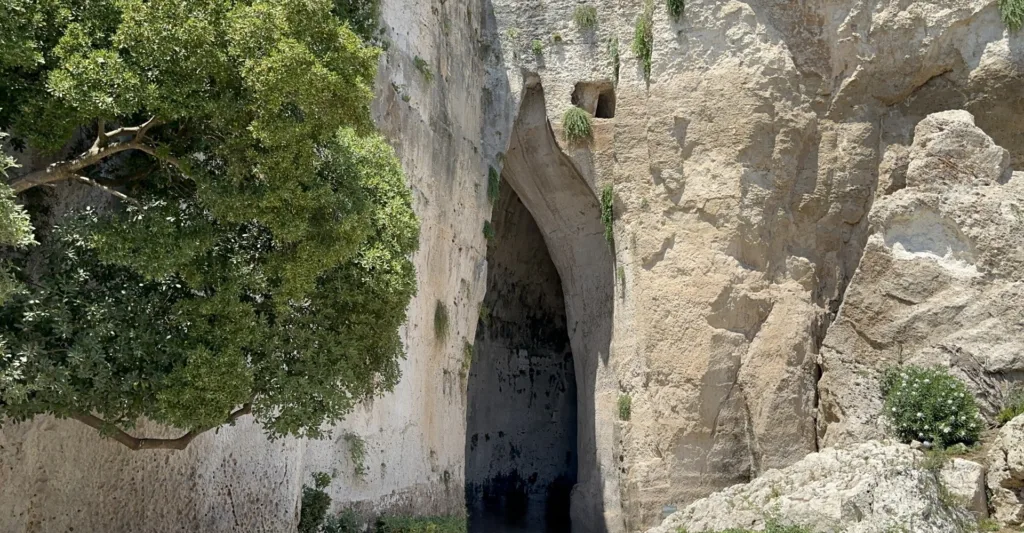By Dr. Themistocles Kritikakos (Historian)
Few places capture Magna Graecia’s dramatic history like the Grand Harbour of Syracuse in Sicily. Walking toward the bridge leading to Ortygia island during my travels last year, I gazed over these tranquil waters and imagined the ancient turmoil that once engulfed this bay. Dotted now with fishing and recreational boats, this peaceful harbour was the setting for one of history’s most catastrophic ancient Greek naval battles.
In 413 BCE, the Athenian fleet, comprising hundreds of ships and representing Athens’ boldest military expedition, found itself confined within this very harbour. What had begun as an ambitious attempt to extend Athenian influence into Sicily ended in a devastating defeat. The large fleet became vulnerable in the harbour’s restricted waters. Syracuse, reinforced by Spartan and Corinthian allies, destroyed the trapped vessels. One after another, the Athenian ships were rammed, set ablaze, or sunk outright. The harbour soon filled with wreckage and casualties as Athens’ naval supremacy was dismantled. This loss was more than a tactical disaster; it marked the beginning of the decline of Athens’ power in the Greek world.

The Foundation and Rise of Syracuse
Syracuse (in present-day Sicily) was founded in 734 BCE by settlers from Corinth and Tenea, led by their oikist (founder), Archias. Starting from the island of Ortygia, the settlers expanded into the nearby swampy area known as Syraka, from which the city derived its name. The original Greek colonists formed an elite landowning class called the gamoroi, whilst the indigenous Sicels comprised the working population.
By the fifth century BCE, Syracuse had developed into a major Greek power, rivalling Athens in military strength, architecture, and intellectual life. It became a flourishing centre for philosophy, science, theatre, and the arts, demonstrating that Greek culture thrived well beyond its Aegean heartland.
Under the rule of Gelon, Syracuse achieved a defining victory by defeating the Carthaginians at the Battle of Himera in 480 BCE. This triumph established Syracuse as the leading Greek city in the western Mediterranean. Using the wealth seized from Carthage, Gelon initiated an ambitious building program that included temples, public buildings, and imposing city walls. Among his notable projects was the Temple of Athena, which was later incorporated into the Christian cathedral.

Archimedes: Genius of Syracuse
Perhaps the most celebrated figure associated with Syracuse was Archimedes (287–212 BCE), widely regarded as one of ancient Greece’s greatest mathematicians and inventors. His contributions laid foundational work in mathematics, including early methods resembling calculus and a remarkably accurate calculation of pi.

Archimedes also made important advances in physics, particularly in hydrostatics and mechanics. His most famous discovery, the principle of buoyancy, arose from a practical problem. Legend says that Greek tyrant Hieron II commissioned him to determine whether a crown was made of pure gold. Whilst bathing, Archimedes observed the displacement of water and reportedly exclaimed “Eureka!” (“I have found it!”). The principle he formulated remains fundamental to science today.
Archimedes was not merely a theorist; he applied his ingenuity in the defence of Syracuse. During the Roman siege of Syracuse (213–212 BCE), he engineered innovative war machines, including catapults and the “Claw of Archimedes,” designed to lift and capsize enemy ships. There is also a long-standing but historically debated claim that he employed mirrors to focus sunlight and set Roman vessels aflame.
Despite these efforts, Syracuse ultimately fell to the Romans in 212 BCE. Archimedes was killed during the city’s capture, despite orders from Marcus Claudius Marcellus that he be spared. His death marked the loss of a brilliant mind and the end of Syracuse’s independence as a Greek city-state.
Military Strength and Innovatio
Syracuse played a crucial role in the Peloponnesian War. Its defeat of the massive Athenian expedition in 413 BCE marked a turning point in the conflict, significantly altering the balance of power in the Greek world. The expedition, which had lasted from 415 to 413 BCE, ended with tens of thousands of Athenians killed or captured during this disaster.
Throughout its history, the city was often governed by tyrants, most notably Dionysius I (The Elder). He expanded Syracuse’s military capabilities and transformed it into a powerful naval force. Under such rulers, Syracuse became a centre for military innovation, influencing Mediterranean warfare strategy for generations.
Cultural and Political Achievements
Syracuse was more than a military power. In the fifth century BCE, under Hieron I, it became a hub of artistic and literary activity. Poets such as Pindar and playwrights including Aeschylus were welcomed. The comic playwright Epicharmus also lived in Syracuse and played a significant role in shaping early Greek comedy. His works influenced subsequent generations, indicating that western Greek cities were centres of innovation, not merely imitators of Athenian culture.
Even Plato visited Syracuse three times with the hope of realising his philosophical and political ideals through mentoring the city’s rulers. Although his attempts to establish a philosopher-king in Dionysius II (The Younger) ultimately failed, these visits underscored Syracuse’s prominence within the intellectual world. The presence of such significant figures demonstrated that Syracuse attracted the finest minds of the age, establishing itself as a genuine rival to Athens in cultural achievement.
Landmarks of Legacy
Among Syracuse’s most iconic landmarks is the Greek Theatre, situated within the Archaeological Park of Neapolis. Initially constructed in the fifth century BCE under Hieron I, the theatre underwent major expansion in the third century BCE when Hieron II enlarged it to accommodate up to 15,000 spectators. With its 138-metre diameter, it was one of the largest theatres in the ancient Greek world. Aeschylus, one of the great ancient Greek tragedians, staged his plays The Persians and Aetnae at the renowned theatre.

The theatre served not only as a venue for dramatic performances but also for political and religious gatherings. Renowned for its excellent acoustics and commanding views, it remains in use today for classical productions, continuing a tradition spanning over two and a half millennia. Nearby is the “Ear of Dionysius,” a cave famed for its extraordinary acoustics. Legend has it that Dionysius I used this cave to eavesdrop on prisoners, although this story is likely a myth. Nonetheless, the cave stands as a vivid symbol of the city’s layered history.

Syracuse’s religious life remained deeply connected to its Greek heritage. The Temple of Athena, now the Cathedral of Syracuse, retains visible Doric columns from the original fifth-century BCE structure. The Fountain of Arethusa, a natural spring, symbolised both mythological and practical aspects of life, linking the city to the broader Greek cultural sphere. Syracuse also established several sub-colonies, including Akrai, Helorus, and Kamarina, which helped disseminate Greek culture and urban planning throughout Sicily.
Layers of Conquest
Sicily’s strategic location made it a crossroads of civilisations. After the Greeks came the Carthaginians, followed by the Romans during the Second Punic War (218-201 BCE). Subsequently, the island was ruled by Byzantines, Arabs, Normans, Swabians, and Spaniards. Each left a distinct legacy. The Byzantines preserved the Greek language and Orthodox Christian traditions. The Arabs introduced advanced irrigation techniques and new crops. These diverse influences shaped a unique cultural mosaic and continue to be visible today in Sicily’s architecture, culture, and cuisine.
Magna Graecia’s Crown Jewel
Syracuse was the crown jewel of Sicily’s contribution to Magna Graecia. Alongside cities such as Gela, founded by settlers from Rhodes and Crete in 698 BCE, and Agrigento (ancient Akragas), founded by colonists from Gela in 582 BCE and famous for its spectacular temples, Syracuse served as a vital link between the Greek world and the western Mediterranean. These cities exchanged goods, ideas, and artistic styles. They also functioned as laboratories of political thought, developing institutions that shaped the future governance of the Greek world and beyond.
Nearby Catania, established by Chalcidian Greeks in the eighth century BCE from the colony of Naxos, lay under the shadow of Mount Etna. The Greeks explained the volcano’s activity through myths that the giant Typhon was imprisoned beneath the mountain.
Today, Syracuse holds UNESCO World Heritage status. Its ancient monuments attract tourists and scholars alike. Syracuse continues to reveal the strength and adaptability of Greek civilisation. It reminds us that Hellenism thrived in new environments. Standing once more by the Grand Harbour where the Athenian fleet met its fate over 2,400 years ago, what is reflected in those waters is that Syracuse was indeed a formidable Greek centre of power.
The Magna Graecia series continues fortnightly
Coming next: Part 5 uncovers Apulia’s Greek cities, including Spartan-founded Taras (present-day Taranto), and Basilicata’s ancient colonies, such as Metaponto.
Links to the series:
Magna Graecia – Part 1: Hellenism beyond the homeland
Magna Graecia – Part 2: The Greek foundations of a new city
Magna Graecia – Part 3: Hellenism cast in bronze
*Dr Themistocles Kritikakos is a Greek-Australian historian, philosopher and writer. He holds a PhD in History from the University of Melbourne. His forthcoming book explores intergenerational memories of violence in the late Ottoman Empire, identity, and communal efforts toward genocide recognition, focusing on the Armenian, Greek, and Assyrian communities in Australia.
